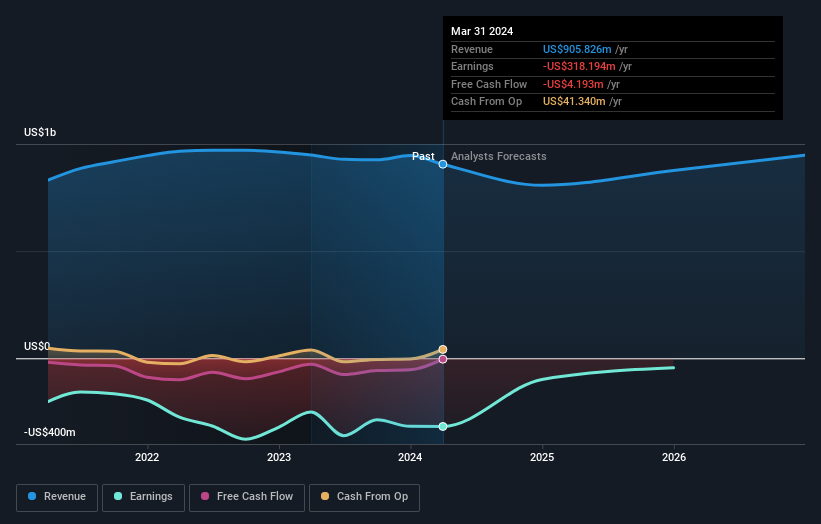Analysts Have Been Trimming Their 2U, Inc. (NASDAQ:TWOU) Price Target After Its Latest Report
Shareholders will be ecstatic, with their stake up 41% over the past week following 2U, Inc.'s (NASDAQ:TWOU) latest quarterly results. Revenues came in at US$198m, in line with forecasts and the company reported a statutory loss of US$0.65 per share, roughly in line with expectations. The analysts typically update their forecasts at each earnings report, and we can judge from their estimates whether their view of the company has changed or if there are any new concerns to be aware of. So we gathered the latest post-earnings forecasts to see what estimates suggest is in store for next year.
See our latest analysis for 2U
Following the recent earnings report, the consensus from six analysts covering 2U is for revenues of US$807.1m in 2024. This implies a not inconsiderable 11% decline in revenue compared to the last 12 months. The loss per share is expected to greatly reduce in the near future, narrowing 69% to US$1.16. Before this earnings announcement, the analysts had been modelling revenues of US$806.7m and losses of US$1.27 per share in 2024. So there seems to have been a moderate uplift in analyst sentiment with the latest consensus release, given the upgrade to loss per share forecasts for this year.
The consensus price target fell 10.0% to US$1.13despite the forecast for smaller losses next year. It looks like the ongoing lack of profitability is starting to weigh on valuations. Fixating on a single price target can be unwise though, since the consensus target is effectively the average of analyst price targets. As a result, some investors like to look at the range of estimates to see if there are any diverging opinions on the company's valuation. The most optimistic 2U analyst has a price target of US$1.50 per share, while the most pessimistic values it at US$0.75. Note the wide gap in analyst price targets? This implies to us that there is a fairly broad range of possible scenarios for the underlying business.
Another way we can view these estimates is in the context of the bigger picture, such as how the forecasts stack up against past performance, and whether forecasts are more or less bullish relative to other companies in the industry. These estimates imply that revenue is expected to slow, with a forecast annualised decline of 14% by the end of 2024. This indicates a significant reduction from annual growth of 13% over the last five years. By contrast, our data suggests that other companies (with analyst coverage) in the same industry are forecast to see their revenue grow 11% annually for the foreseeable future. So although its revenues are forecast to shrink, this cloud does not come with a silver lining - 2U is expected to lag the wider industry.
The Bottom Line
The most important thing to take away is that the analysts reconfirmed their loss per share estimates for next year. Fortunately, the analysts also reconfirmed their revenue estimates, suggesting that it's tracking in line with expectations. Although our data does suggest that 2U's revenue is expected to perform worse than the wider industry. Furthermore, the analysts also cut their price targets, suggesting that the latest news has led to greater pessimism about the intrinsic value of the business.
With that said, the long-term trajectory of the company's earnings is a lot more important than next year. We have estimates - from multiple 2U analysts - going out to 2026, and you can see them free on our platform here.
Plus, you should also learn about the 4 warning signs we've spotted with 2U (including 1 which is a bit concerning) .
Have feedback on this article? Concerned about the content? Get in touch with us directly. Alternatively, email editorial-team (at) simplywallst.com.
This article by Simply Wall St is general in nature. We provide commentary based on historical data and analyst forecasts only using an unbiased methodology and our articles are not intended to be financial advice. It does not constitute a recommendation to buy or sell any stock, and does not take account of your objectives, or your financial situation. We aim to bring you long-term focused analysis driven by fundamental data. Note that our analysis may not factor in the latest price-sensitive company announcements or qualitative material. Simply Wall St has no position in any stocks mentioned.

